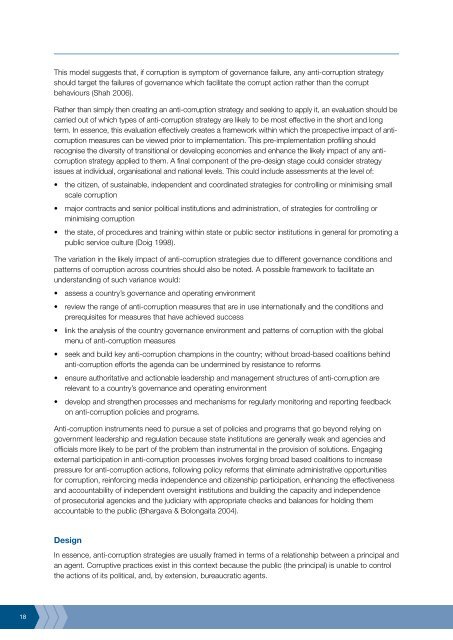Review of anti-corruption strategies Rob McCusker - Australian ...
Review of anti-corruption strategies Rob McCusker - Australian ...
Review of anti-corruption strategies Rob McCusker - Australian ...
You also want an ePaper? Increase the reach of your titles
YUMPU automatically turns print PDFs into web optimized ePapers that Google loves.
This model suggests that, if <strong>corruption</strong> is symptom <strong>of</strong> governance failure, any <strong>anti</strong>-<strong>corruption</strong> strategy<br />
should target the failures <strong>of</strong> governance which facilitate the corrupt action rather than the corrupt<br />
behaviours (Shah 2006).<br />
Rather than simply then creating an <strong>anti</strong>-<strong>corruption</strong> strategy and seeking to apply it, an evaluation should be<br />
carried out <strong>of</strong> which types <strong>of</strong> <strong>anti</strong>-<strong>corruption</strong> strategy are likely to be most effective in the short and long<br />
term. In essence, this evaluation effectively creates a framework within which the prospective impact <strong>of</strong> <strong>anti</strong><strong>corruption</strong><br />
measures can be viewed prior to implementation. This pre-implementation pr<strong>of</strong>iling should<br />
recognise the diversity <strong>of</strong> transitional or developing economies and enhance the likely impact <strong>of</strong> any <strong>anti</strong><strong>corruption</strong><br />
strategy applied to them. A final component <strong>of</strong> the pre-design stage could consider strategy<br />
issues at individual, organisational and national levels. This could include assessments at the level <strong>of</strong>:<br />
•<br />
•<br />
•<br />
the citizen, <strong>of</strong> sustainable, independent and coordinated <strong>strategies</strong> for controlling or minimising small<br />
scale <strong>corruption</strong><br />
major contracts and senior political institutions and administration, <strong>of</strong> <strong>strategies</strong> for controlling or<br />
minimising <strong>corruption</strong><br />
the state, <strong>of</strong> procedures and training within state or public sector institutions in general for promoting a<br />
public service culture (Doig 1998).<br />
The variation in the likely impact <strong>of</strong> <strong>anti</strong>-<strong>corruption</strong> <strong>strategies</strong> due to different governance conditions and<br />
patterns <strong>of</strong> <strong>corruption</strong> across countries should also be noted. A possible framework to facilitate an<br />
understanding <strong>of</strong> such variance would:<br />
•<br />
•<br />
•<br />
•<br />
•<br />
•<br />
assess a country’s governance and operating environment<br />
review the range <strong>of</strong> <strong>anti</strong>-<strong>corruption</strong> measures that are in use internationally and the conditions and<br />
prerequisites for measures that have achieved success<br />
link the analysis <strong>of</strong> the country governance environment and patterns <strong>of</strong> <strong>corruption</strong> with the global<br />
menu <strong>of</strong> <strong>anti</strong>-<strong>corruption</strong> measures<br />
seek and build key <strong>anti</strong>-<strong>corruption</strong> champions in the country; without broad-based coalitions behind<br />
<strong>anti</strong>-<strong>corruption</strong> efforts the agenda can be undermined by resistance to reforms<br />
ensure authoritative and actionable leadership and management structures <strong>of</strong> <strong>anti</strong>-<strong>corruption</strong> are<br />
relevant to a country’s governance and operating environment<br />
develop and strengthen processes and mechanisms for regularly monitoring and reporting feedback<br />
on <strong>anti</strong>-<strong>corruption</strong> policies and programs.<br />
Anti-<strong>corruption</strong> instruments need to pursue a set <strong>of</strong> policies and programs that go beyond relying on<br />
government leadership and regulation because state institutions are generally weak and agencies and<br />
<strong>of</strong>ficials more likely to be part <strong>of</strong> the problem than instrumental in the provision <strong>of</strong> solutions. Engaging<br />
external participation in <strong>anti</strong>-<strong>corruption</strong> processes involves forging broad based coalitions to increase<br />
pressure for <strong>anti</strong>-<strong>corruption</strong> actions, following policy reforms that eliminate administrative opportunities<br />
for <strong>corruption</strong>, reinforcing media independence and citizenship participation, enhancing the effectiveness<br />
and accountability <strong>of</strong> independent oversight institutions and building the capacity and independence<br />
<strong>of</strong> prosecutorial agencies and the judiciary with appropriate checks and balances for holding them<br />
accountable to the public (Bhargava & Bolongaita 2004).<br />
Design<br />
In essence, <strong>anti</strong>-<strong>corruption</strong> <strong>strategies</strong> are usually framed in terms <strong>of</strong> a relationship between a principal and<br />
an agent. Corruptive practices exist in this context because the public (the principal) is unable to control<br />
the actions <strong>of</strong> its political, and, by extension, bureaucratic agents.















